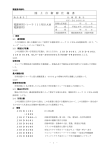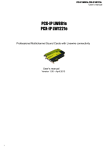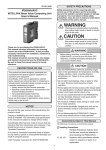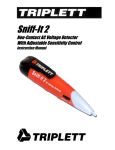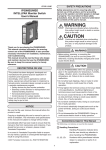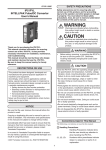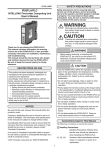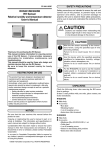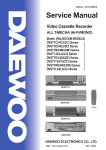Download SIA, SIB, SIC, SID User's Manual
Transcript
No. CP-UM-1221E SIA, SIB, SIC, SID Smart Indicator with LED Bar Graph User's Manual Thank you for purchasing the SIA, SIB, SIC and SID. This manual contains information for ensuring the correct use of the SIA, SIB, SIC and SID. It also provides necessary information for installation, maintenance, and troubleshooting. This manual should be read by those who design and maintain equipment that uses the SIA, SIB, SIC and SID. Be sure to keep this manual nearby for handy reference. RESTRICTIONS ON USE This product has been designed, developed and manufactured for general-purpose application in machinery and equipment. Accordingly, when used in applications outlined below, special care should be taken to implement a fail-safe and/or redundant design concept as well as a periodic maintenance program. • Safety devices for plant worker protection • Start/stop control devices for transportation and material handling machines • Aeronautical/aerospace machines • Control devices for nuclear reactors Never use this product in applications where human safety may be put at risk. NOTICE Be sure that the user receives this manual before the product is used. Copying or duplicating this user’s manual in part or in whole is forbidden. The information and specifications in this manual are subject to change without notice. Considerable effort has been made to ensure that this manual is free from inaccuracies and omissions. If you should find an error or omission, please contact Yamatake Corporation. In no event is Yamatake Corporation liable to anyone for any indirect, special or consequential damages as a result of using this product. ©1998 Yamatake Corporation ALL RIGHTS RESERVED CONTENTS 1. GENERAL . . . . . . . . . . . . . . . . . . . . . . . . . . . . . . . . . . . . . . . . . . . . . . . . . . .1 2. DIMENSIONS AND INSTALLATION . . . . . . . . . . . . . . . . . . . . . . . . . . . . . . .2 3. WIRING . . . . . . . . . . . . . . . . . . . . . . . . . . . . . . . . . . . . . . . . . . . . . . . . . . . . .3 4. ALARM SETTING AND ZERO-SPAN ADJUSTMENT . . . . . . . . . . . . .4 to 5 5. SPECIFICATIONS AND MODEL NUMBERS . . . . . . . . . . . . . . . . . . . . . . . .6 1. GENERAL The Smart Indicator is a compact, lightweight, highly reliable, DIN-compatible LED bar graph indicator for process monitoring. Features • Bar graph with high-intensity custom LEDs. • Three bar display colors: red, green and yellow, selectable. • Easy alarm setting and zero span adjustment from the front panel. 2. DIMENSIONS AND INSTALLATION 1. External dimensions Unit : mm Unit identification and number (nameplate) Mounting spacer 160 139 144 138.1 16 135 Fig.2 Fig.1 Mounting spacer Side 9.4 144 9 36 Front 7.5 35 138.1 41 2. Panel dimensions 3. installation of panel Fixing bracket Installation of single unit Mounting spacer Side-by-side close mounting (36 X N) +10 +1 Mounting spacer Over 190 Over 190 139.5 +10 139.5 +10 35.5 +10 Fig.4 N: No. of units mounted. No. of mounting spacers: One spacer on each side of panel, either for single-unit or multi-unit installation. Fixing bracket Nameplate Mounting screw Fig.3 Fig.5 1 4. Panel mounting method (1) Attach the included mounting spacers to the right and left sides of the instrument body. (2) Insert the instrument body into the panel cutout. (3) Mounting screws are located at the top and bottom behind the two nameplates. With a phillips head screwdriver, turn the screws clockwise to raise the fixing bracket the secure the instrument body in place. (4) To remove the instrument from the panel, simply turn the screws counterclockwise. 5. Choose installation Choose a location that meets the following requirements: Operating conditions Ambient temperature: SIA, SIB: 0 to 50°C SIC, SID: 0 to 45°C Ambient humidity: 80% RH at 40°C Vibration resistance: 4.9m/s2 (10 to 60Hz) Shock resistance: 490m/s2 Cautions • Do not mount the instrument in an environment where these is flammable gas. • Do not use the instrument in a highly corrosive atmosphere. • Distance the instrument from any potential source of electrical interference: large-capacity electromagnetic switches, high-frequency generating units, SCR units, or the like. 3. WIRING 1. Cables (1) For the input signal, use a shielded cable suitable for measuring-instrument use. (2) Use a 600V vinyl insulated cable (IV cable) conforming to JIS C3307 for the 100/110Vac power supply. Cautions • Leave space of more than 50cm between the input signal cable and the power line. • Do not run the input signal cable and the power line in the same conduit, or in close proximity. • Distance the input signal cable from the power, high voltage and load lines. • The above conditions also apply to internal panel wiring. 2. Terminal connection (1) Use solderless terminals that take M3 screws. (2) The instrument is not equipped with a power switch. Mount one separately, if necessary. (3) Connect wiring according to the terminal connection diagram. Make sure that the cables have been connected correctly. Terminal connection diagram SIA type 1 SIB type SIC type 1 Input SID type 1 Input No.1 Input 2 2 3 3 3 Hc 4 4 4 Ha 5 Hb 2 5 6 7 8 Input No.2 Power supply 24Vdc Power supply 100V/110V 200V/220V AC 50/60Hz 120V 240V 5 6 7 8 Power supply 24Vdc Power supply 100V/110V 200V/220V AC 50/60Hz 120V 240V 1 Input 2 3 H(H)c 4 HHa 5 HHb 6 6 Ha 7 7 La 8 LLa 8 La 9 Lb 10 Lc 11 12 H side output L side output Power supply 24Vdc 100V/110V 200V/220V AC 50/60Hz 120V 240V ( )Polarilty of 24Vdc power supply 2 9 LLb 10 L(L)c 11 HH side output H side output LL side output L side output Power supply 24Vdc 100V/110V 200V/220V AC 50/60Hz 120V 240V ( )Polarilty of 24Vdc power supply 12 4. ALARM SETTING AND ZERO SPAN ADJUSTMENT 1. Location For SIA and SIB types: The zero and span control knobs are accessible by removing the nameplates, acrylic cover and scale plate. Adjust the knobs according to the instructions in Section 4.3. For SIC and SID types: First remove the nameplates and acrylic cover. Set the alarm and adjust the zero and span knobs according to the instructions in Section 4.3. SIA and SIB types SIC and SID types Span control knob Nameplate Acrylic cover Scale plate Zero control knob Alarm setting/zero-span adjustment Fig.7 2. Alarm setting (SIC and SID) 2-1 Setting/indicating SET Set point operation button High-high-limit set point Flashes during high-high-limit setting. Lights up during relay action. Flashes during high-limit setting. Lights up during relay action. High-limit set point Light up during PV input span adjustment. Light up during PV indicating value clear (erase). Low-limit set point Light up during PV input zero adjustment. Flashes during low-limit setting. Lights up during relay action. Low-low-limit set point Flashes during low-low-limit setting. Lights up during relay action. Moves set point up. PV indicating value Mode selector button. Modes change in direction of arrow, when button is pushed. Moves set point down. Fig.8 2.2 Selection of setting modes (1) When the M mode selector button is pushed, all LEDs either flash or light up and a setting mode can be selected. (2) LL, L, H, and HH LEDs ( ) flash during mode selection and light up during relay action. (3) When the or button is pushed, the setting mode shifts upward or downward. For rapid mode shifting, push and hold for at least 3 seconds. (4) The PV indicating value can be erased by selecting the PV indicating value clear mode. 2.3 Setting of high-limit (H) and high-high limit (HH) (1) Select either the high-limit (H) or high-high limit (HH) mode by pushing (2) Set either a high or high-high limit value by moving the setting bar up (3) Load a set point by pushing SET . The LED should go out. 3 M. The LED should flash. or down . 2.4 Setting of low-limit (L) and low-low limit (LL) (1) Select either the low-limit (L) or low-low limit (LL) mode by pushing (2) Set either a low or low-low limit value by moving the setting bar up (3) Load a set point by pushing SET. The LED should go out. M. The LED should flash. or down . 2.5 About the hysteresis of the alarm contacts The hysteresis of the SIC and SID is different from the operating differential of a general temperature controller. It goes through the process described below. (For a high-limit alarm) (1) When the set point = the PV value, the relay contact turns ON. (2) In the next instant, the internal set point decreases 5% FS. (3) After 100ms, the internal set point increases 0.5% FS from the above (2) state, and comparison is made between the internal set point and the PV value. If the internal set point > PV value, the contact turns OFF. (4) Afterwards, at 100ms intervals, the internal set point increases every 0.5% up to the value of (internal set point —1.0% FS), and each time the internal set point is compared to the PV value. If the internal set point > the PV value, the contact turns OFF. (5) At 1000ms, the internal set point returns to the original set point. When SP > PV value, the contact turns OFF. (1)At next instant SP (2) After 100ms (3) SP SP 4.5%FS 5%FS ON After 1000ms (5) SP 1.0%FS Internal SP SP Internal SP Internal SP Contact After 800ms (4) ON ON ON OFF Note: For a low-limit alarm, the process is reversed. 3. Zero and span adjustment For SIA and SIB types: Span control knob: Adjust the knobs to the desired value. Value increases when knob is turned clockwise and decreases when knob is turned counterclockwise. Zero control knob: Fig.9 For SIC and SID types: (1) Zero adjustment (See Fig.8) 1. Select the zero adjusting mode (Z) by pushing M. The Z lamp should flash. 2. Set the desired value by moving the PV indicating bar up or down with or 3. Load a set point by pushing SET. The LED should go out. (2) Span adjustment (See Fig.8) 1. Select the span adjusting mode (S) by pushing M. The S lamp should flash. 2. Set the desired value by moving the PV indicating lever up or down with or 3. Load a set point by pushing SET. The LED should go out. 4 . . 5. SPECIFICATIONS AND MODEL NUMBERS Model Input Model No. No. of indicating points Alarm Input type Response speed Input impedance Indication Input adjustment range Indication method Number of bar dots Effective scale length Indication range Indication accuracy Alarm setting Setting range unit (SIC and SID) Setting accuracy Output and rating SIA 1 SIB 2 SIC 1 SID 1 – – High/low limit High-high limit/ low-low limit Current: 4 to 20mA, and 0 to 1mAdc. Voltage: 0 to 1Vdc, and 0 to 5Vdc. 0.5s (90% response) 4 to 20mA input: 10Ω. 0 to 1mAdc input: 200Ω. 1 to 5Vdc, 1 to 5Vdc and 0 to 5Vdc: 1MΩ. ±10% FS (for both ZERO and SPAN) Red, green or yellow LED bar dots (color selectable) Flashing display (SIA and SIB only) when input is complete. 101 100mm 0 to 100% FS ±1% FS ±1 digit High/low High limit value (H): 100% FS to (low limit value +1% FS) limit Low limit value (L): (high limit value -1% FS) to 0% High-high High-high limit value (HH): 100% FS to (high limit value +1% FS) limit/low-low High limit value (H): (high-high limit value -1% FS to (low limit value limit +1% FS) Low limit value (L): (high limit value -1% FS) to (low-low limit value +1% FS) Low-low limit value (LL): (low limit value -1% FS) to 0% ±1% FS ±1 digit Non-voltage contact (SIC: 2C, SID: 2c+2a), 125Vac 0.5A and 30Vdc 2A (resistive load). Contact life: 500,000 cycle min. (at rated load). Settings are safely stored in nonvolatile RAM. Power failure compensation Ambient 0 to 50°C temperature General Power consumption AC power: 5VA AC power: 5VA 24Vdc power: 2W 24Vdc power: 4W specifications Insulation 50MΩ min. by DC500V megger resistance between circuit and case Dielectric strength 2000Vac for 1 min between circuit and case. AC power: 1500Vac for 1 min between power and input terminal. 24Vdc power: 500Vac for 1 min between power and input terminal. 500Vac for 1 min between input No. 1 and input No. 2. Mass (weight) Vibration resistance Shock resistance Case and cover materials Standard color Additional treatment Mounting Mounting angle Standard accessories Selectable 0 to 45°C 10MΩ min. by DC500V megger between circuit and case 1500Vac for 1 min between circuit and case. AC power: 1500Vac for 1 min between power and input terminal. 24Vdc power: 1500Vac for 1 min between power and input terminal, between output contact and case, between output contact and power, and between output contact and circuit. Approx. 400g Approx. 500g Approx. 590g 4.9m/s2 max. (10 to 60Hz) 490m/s2 max. Case: ABS resin. Cover: acrylic resin. Nameplate: ABS resin. Scale: black colored aluminum. Bezel and case: moss green (Munsell 2.5GY3/1). Flush-mounted on indoor panel 0 to 90° (in any direction) Mounting spacers (2 units) With inspection certificate and/or tropicalization 5 SI Series Model Selection Guide Model I I II III IV II V VI III Basic Model Power Supply Number Voltage Input IV V VI No.1 Display No.1 Display No.2 Display No.2 Display Additional Colour Range Colour Range Processing SIA SIB SIC SID 1 display 2 displays 1 display High/low limit alarm 1 display High-high limit/ low-low limit alarm 100V/110Vac 50/60Hz 200V/220Vac 50/60Hz 120Vac 50/60Hz 40Vac 50/60Hz 24Vdc 4 to 20mAdc 0 to 1mAdc 0 to 1Vdc 1 to 5Vdc 0 to 5Vdc Red Green Yellow 1 2 5 6 8 C F L V Y R G Y See Range Code select Table R G Y Red Green Yellow See Range Code select Table — D T B Y None Inspection certificate provided Tropicalization treatment Tropicalization treatment + Inspection certificate provided Complying with the traceability certification Range Code select Table Description A C D H I O X Y Z U S T V W m3/h[N] % m3/h l/min °C pH m mm - ppmhPa Pa kPa MPa Mantissa Model 1 2 3 4 5 6 7 8 9 A B C D E F G H I J 1 2 3 4 5 6 7 8 9 15 25 35 4 55 65 75 85 95 14 Index Model 7 8 9 0 1 2 3 4 5 6 10-3 10-2 10-1 100 101 102 103 104 105 106 Hi/Lo Model X W Range limits When the low limit value of the range is 0 When the range is “- (low limit value) to + (high limit value)”. However, the absolute high and low limit values must be the same. Unit Selection Model Example: (1) SIA 8 C R A32X T (2) SIB 8 C R A32X G S50W T 3 Range: Range: 0 to 300 Nm /h 3 x10 2 A (Unit) 3 (Mantissa) 2 (Index) X (0 low limit) 5 hPa 5 x10 0 S (Unit) 5 (Mantissa) 0 (Index) W ( limit) Specifications are subject to change without notice. Advanced Automation Company 1-12-2 Kawana, Fujisawa Kanagawa 251-8522 Japan URL: http://www.azbil.com Printed on recycled paper. (07) Printed in Japan. 1st Edition: Issued in July 1998 7th Edition: Issued in May 2007 (M)








